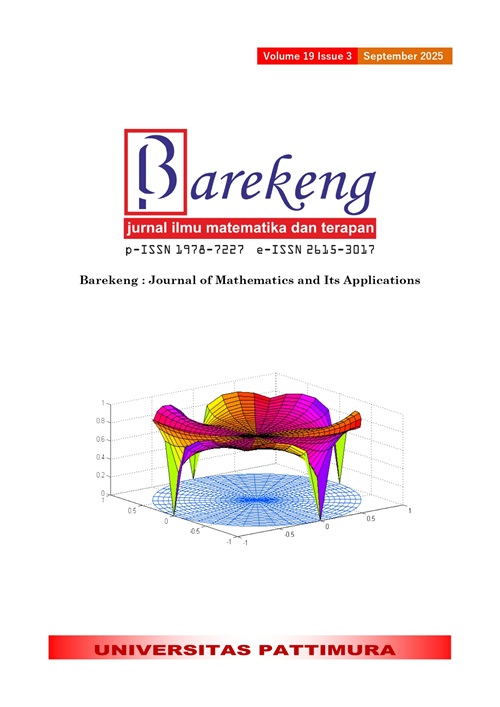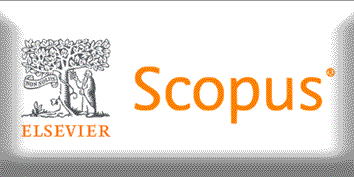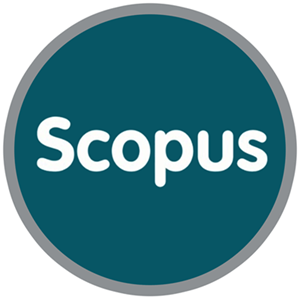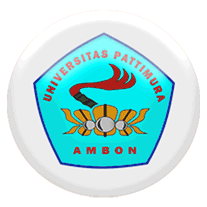DETERMINING TEACHING SCHEDULE AT STATE SENIOR HIGH SCHOOL 1 DEPOK USING ASSIGNMENT THEORY WITH HUNGARIAN METHOD AND NEW IMPROVED ONES ASSIGNMENT METHOD ASSISTED BY PYTHON
Abstract
Every school has a lesson schedule that describes the allocation of teacher assignments to certain lesson hours in each class. The teaching schedule at State Senior High School 1 Depok is still made manually. Therefore, assignment theory using the Hungarian method and the New Improved Ones Assignment (NIOA) method assisted by Python is an alternative for automating the schedule creation process. The purpose of this research is to determine (1) the assignment model, (2) the application of the Hungarian method, (3) the application of the NIOA method, and (4) a comparison of the process and results using both methods from the teaching schedule at State Senior High School 1 Depok. The following research results were obtained. The assignment model can be arranged into assignment tables, which contain teacher codes in the rows, day and lesson hour codes in the columns, and the availability of teacher’s teaching hours, which is filled in with entry 1 if the teacher can teach and 0 if the teacher cannot teach in the corresponding cells. Those tables are processed using Python according to Hungarian and NIOA assignment algorithms. The difference in the application of the two methods is only in the algorithm for finding the initial basic feasible solution. Overall, the two methods applied produce the same schedule results. Differences in results are obtained if two teachers can only teach at the same time.
Downloads
References
T. Birbas, S. Daskalaki, and E. Housos, “SCHOOL TIMETABLING FOR QUALITY STUDENT AND TEACHER SCHEDULES,” J Sched, vol. 12, pp. 77–197, 2009.doi: https://doi.org/10.1007/s10951-008-0088-2.
N. B. Reinke, “THE IMPACT OF TIMETABLE CHANGES ON STUDENT ACHIEVEMENT AND LEARNING EXPERIENCES,” Nurse Educ Today, vol. 62, pp. 137–142, 2018.doi: https://doi.org/10.1016/j.nedt.2017.12.015
A. S. Olaifa, A. Sunday, R. M. Oladimeji, E. O. Olaifa, and A. A. Shittu, “PRINCIPALS’ TIME TABLING PRACTICES AND SCHOOL EFFECTIVENESS IN ILORIN METROPOLIS SECONDARY SCHOOLS, KWARA STATE,” INCOME: Innovation of Economics and Management, vol. 4, no. 3, pp. 68–80, 2025.doi: https://doi.org/10.31538/cjotl.v4i2.1745.
I. A. CHUSNA, “G BANGUN SISTEM PENJADWALAN GURU MENGAJAR BERBASIS WEB (Studi Kasus: SMPN 2 Dawarblandong, Mojokerto),” Jurnal Manajemen Informatika, vol. 7, no. 2, 2017.
A. Puspasari, K. Novianingsih, and F. Agustina, “PENYELESAIAN MASALAH PENJADWALAN PERKULIAHAN MENGGUNAKAN ALGORITMA GENETIKA (STUDI KASUS DI DEPARTEMEN PENDIDIKAN MATEMATIKA FPMIPA UNIVERSITAS PENDIDIKAN INDONESIA),” Jurnal EurekaMatika, vol. 7, no. 1, pp. 80–92, 2019.
L. A. Pangestu, S. H. Suryawan, and A. J. Latipah, “PENERAPAN ALGORITMA GENETIKA DALAM PENJADWALAN MATA PELAJARAN,” JURNAL INFORMATIKA, vol. 10, no. 2, pp. 194–205, 2023.doi: https://doi.org/10.31294/inf.v10i2.16701
Y. Karma, N. Hidayat, and M. Marji, “Optimasi PENJADWALAN KEGIATAN BELAJAR MENGAJAR PADA PONDOK PESANTREN MENGGUNAKAN ALGORITME GENETIKA (STUDI KASUS: PONDOK PESANTREN YAYASAN BANI SYIHAB NASRULLOH),” Jurnal Pengembangan Teknologi Informasi Dan Ilmu Komputer, vol. 5, no. 6, pp. 2768–2774, 2021.
X. Chen, X.-G. Yue, R. Li, A. Zhumadillayeva, and R. Liu, “DESIGN AND APPLICATION OF AN IMPROVED GENETIC ALGORITHM TO A CLASS SCHEDULING SYSTEM,” International Journal of Emerging Technology in Learning, vol. 16, no. 1, pp. 44–59, 2021.doi: https://doi.org/10.3991/ijet.v16i01.18225
L. Minna and L. Yanxiang, “DESIGN AND IMPLEMENTATION OF COURSE SCHEDULING SYSTEM BASED ON B/S,” Computer Knowledge and Technology, vol. 6, no. 5, 2015.
F. H. Ruhiyat and R. A. Permana, “PENJADWALAN KEGIATAN PERKULIAHAN MENGGUNAKAN GOAL PROGRAMMING: STUDI KASUS DI PROGRAM STUDI S1 MATEMATIKA FMIPA IPB,” Jurnal Matematika dan Aplikasinya, vol. 14, no. 2, pp. 45–56, 2015.doi: https://doi.org/10.29244/jmap.14.2.45-56
D. Wungguli and N. Nurwan, “PENERAPAN MODEL INTEGER LINEAR PROGRAMMING DALAM OPTIMASI PENJADWALAN PERKULIAHAN SECARA OTOMATIS,” BAREKENG: J. Math. & App., vol. 14, no. 3, 2020.doi: https://doi.org/10.30598/barekengvol14iss3pp411-422
K. Hermanto, R. Suarantalla, and S. Sahdan, “APLIKASI PROGRAM LINIER INTEGER 0-1 UNTUK MENYUSUN JADWAL USULAN PIKET SATPOL PP,” BAREKENG: J. Math. & App., vol. 14, no. 1, 2020.doi: https://doi.org/10.30598/barekengvol14iss1pp091-100
H. W. Kuhn, “THE HUNGARIAN METHOD FOR THE ASSIGNMENT PROBLEM,” Naval Research Logistics Quarterly, vol. 2, no. 1–2, 1955.doi: https://doi.org/10.1002/nav.3800020109
J. J. Siang, RISET OPERASI DALAM PENDEKATAN ALGORITMIS. Yogyakarta: Andi Publisher, 2011.
R. Murugesan and T. Esakkiammal, “A NOTE ON REVISED ONES ASSIGNMENT METHOD AND NEW IMPROVED ONES ASSIGNMENT METHOD,” Applied Mathematical Sciences, vol. 14, no. 19, 2020.doi: https://doi.org/10.12988/ams.2020.914295
H. Basirzadeh, “ONES ASSIGNMENT METHOD FOR SOLVING TRAVELING SALESMAN PROBLEM,” Journal of mathematics and computer science, vol. 10, pp. 258–265, 2014.doi: https://doi.org/10.22436/jmcs.010.04.04
D. Sudha and D. Vanisri, “FINDING AN OPTIMAL SOLUTION OF AN ASSIGNMENT PROBLEM BY IMPROVED ZERO SUFFIX METHOD,” nternational Journal for Research in Applied Science and Engineering Technology (IJRASET), vol. 3, no. 11, pp. 502–507, 2015.
M. Khalid, M. Sultana, and F. Zaidi, “NEW IMPROVED ONES ASSIGNMENT METHOD,” Applied Mathematical Sciences, 2014.doi: https://doi.org/10.12988/ams.2014.45327
J. Campbell, P. Gries, and J. Montojo, PRACTICAL PROGRAMMING: AN INTRODUCTION TO COMPUTER SCIENCE USING PYTHON. Dallas, Texas: The Pragmatic Bookshelf, 2009.
A. Gupta, “COMPARISON IN JAVA AND PYTHON: A REVIEW PAPER,” International Journal of Innovative Research in Computer Science & Technology (IJIRCST), vol. 10, no. 2, 2022.
Ozgur, T. Colliau, G. Rogers, and Z. Hughes, “MATLAB VS. PYTHON VS. R,” Journal of Data Science, vol. 15, no. 3, 2021.doi: https://doi.org/10.6339/JDS.201707_15(3).0001
H. Nawawi and M. Martini, PENELITIAN TERAPAN. Yogyakarta: Gadjah Mada University Press, 2005.
W. L. Winston, OPERATIONS RESEARCH APPLICATIONS AND ALGORITHMS FOURTH EDITION. Belmont: Brooks/Cole, 2004.
Eason, “HUNGARIAN ALGORITHM INTRODUCTION & PYTHON IMPLEMENTATION,” Medium.
Copyright (c) 2025 Catherine Richelle Hindarto, Febi Sanjaya

This work is licensed under a Creative Commons Attribution-ShareAlike 4.0 International License.
Authors who publish with this Journal agree to the following terms:
- Author retain copyright and grant the journal right of first publication with the work simultaneously licensed under a creative commons attribution license that allow others to share the work within an acknowledgement of the work’s authorship and initial publication of this journal.
- Authors are able to enter into separate, additional contractual arrangement for the non-exclusive distribution of the journal’s published version of the work (e.g. acknowledgement of its initial publication in this journal).
- Authors are permitted and encouraged to post their work online (e.g. in institutional repositories or on their websites) prior to and during the submission process, as it can lead to productive exchanges, as well as earlier and greater citation of published works.






1.gif)



